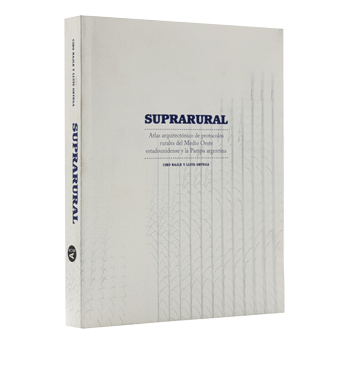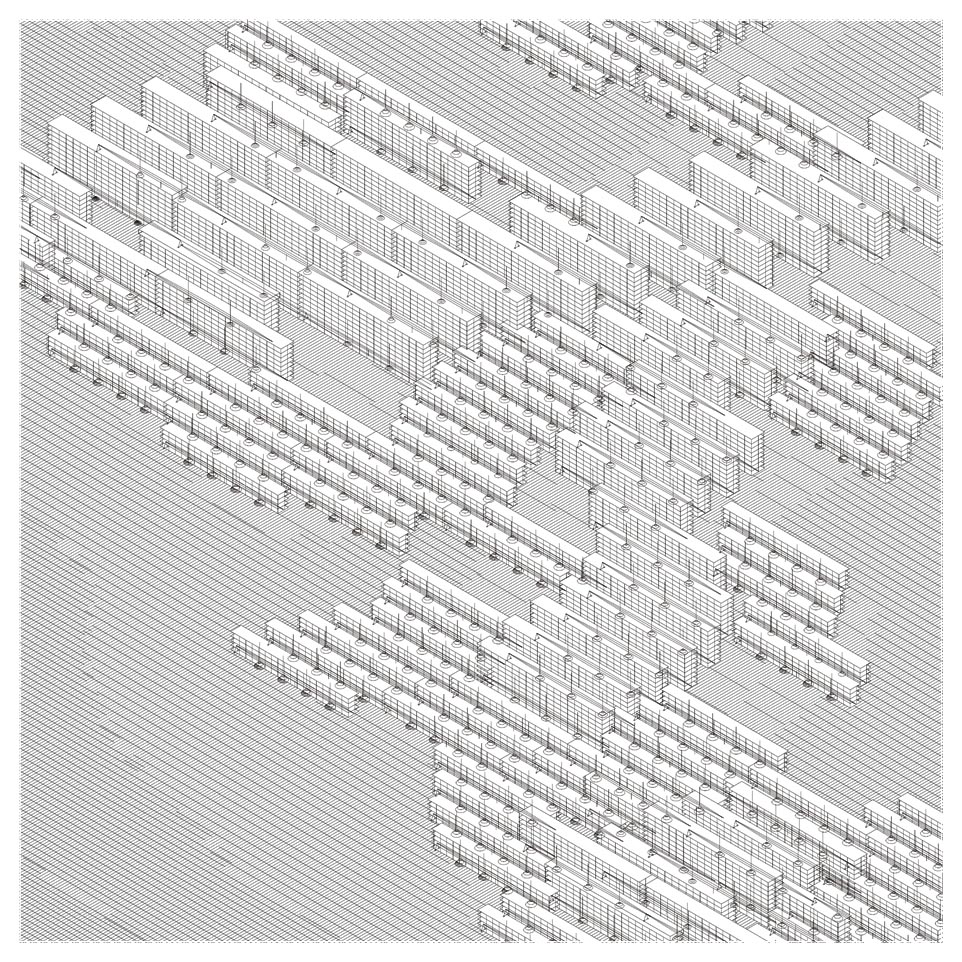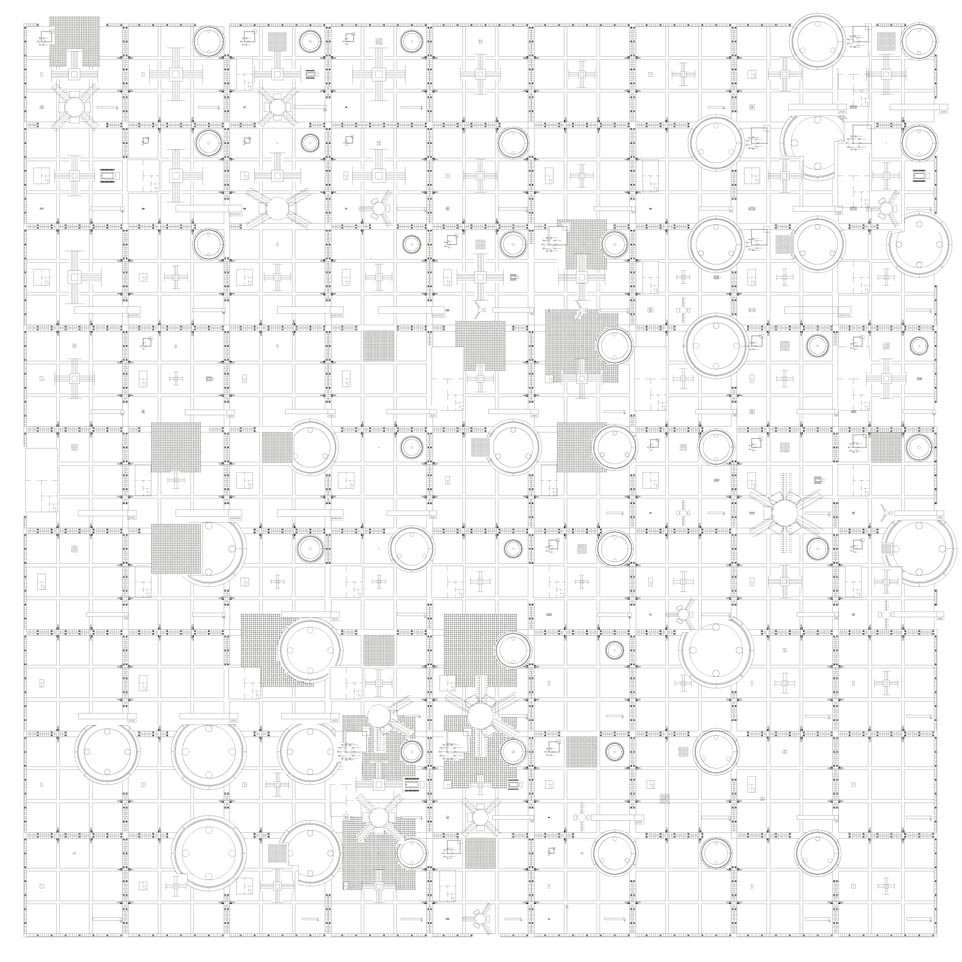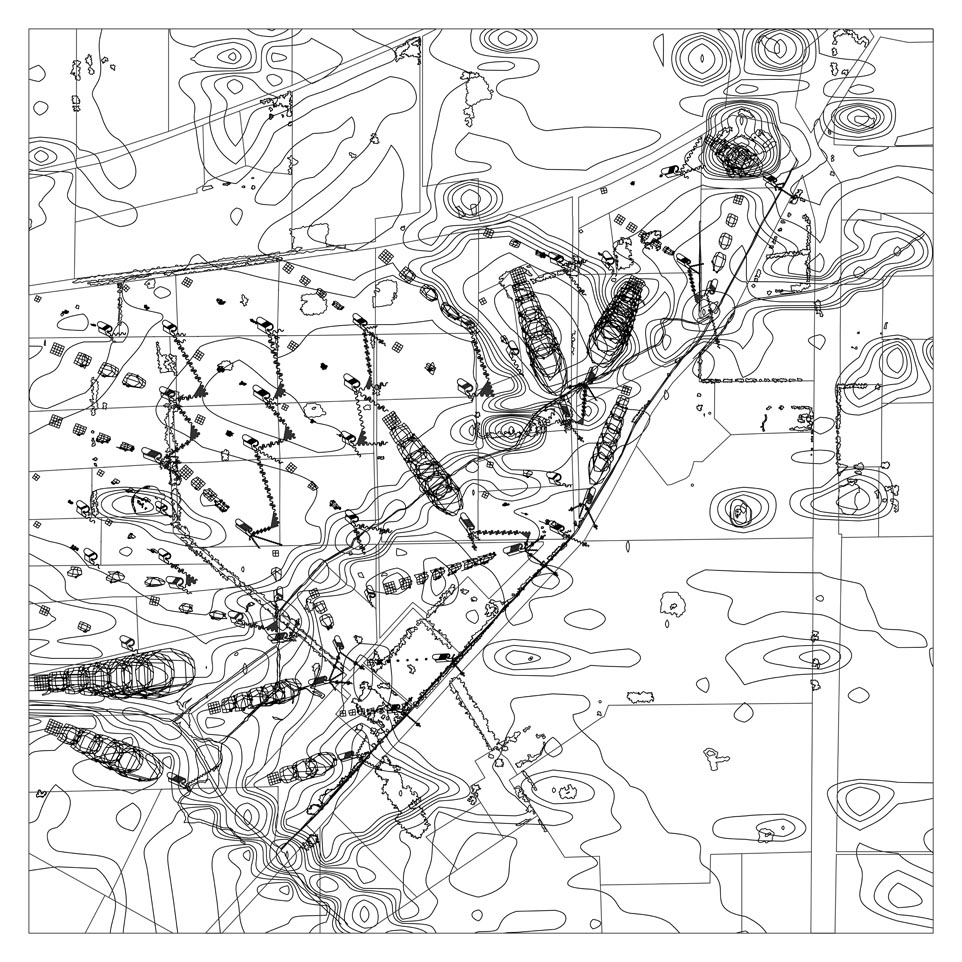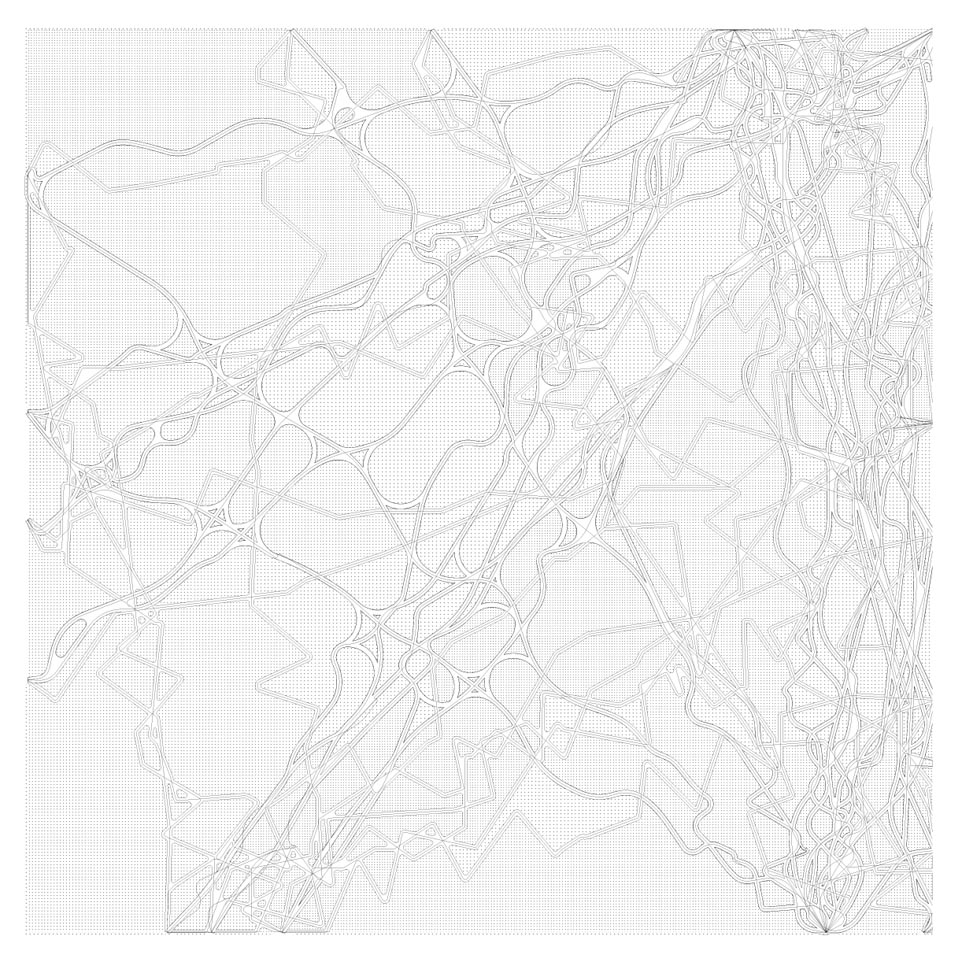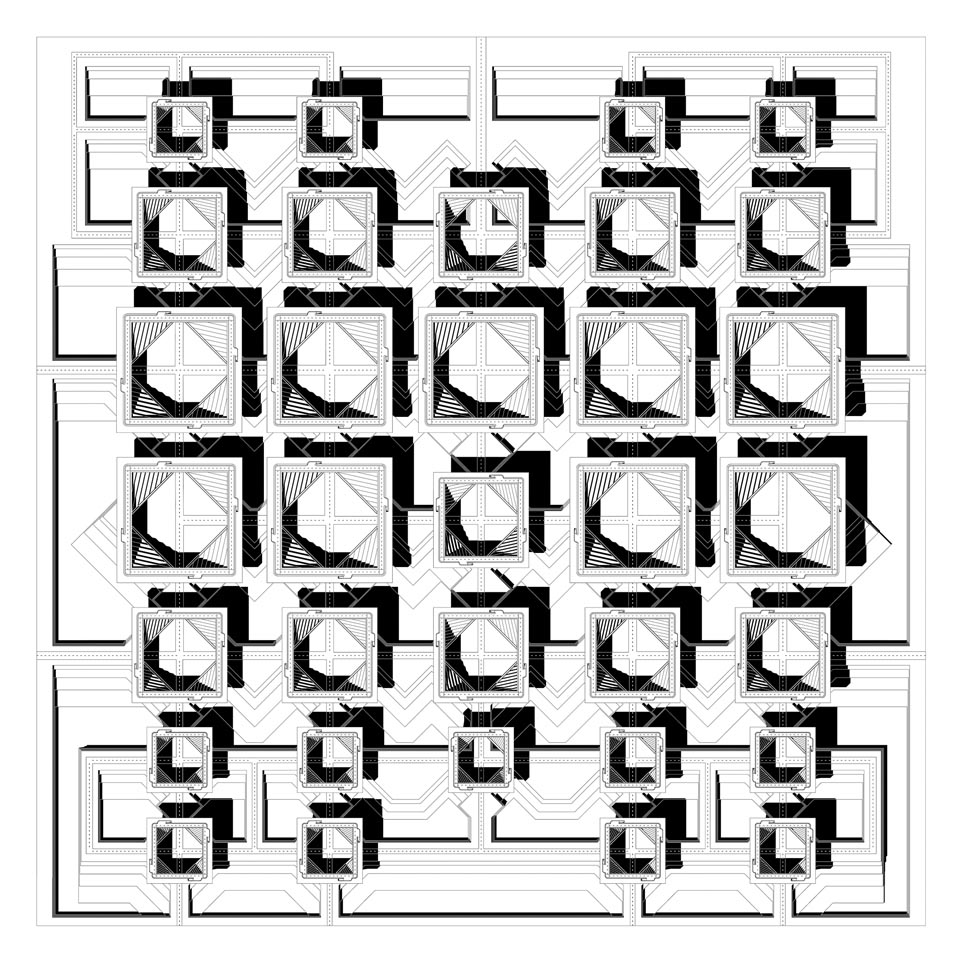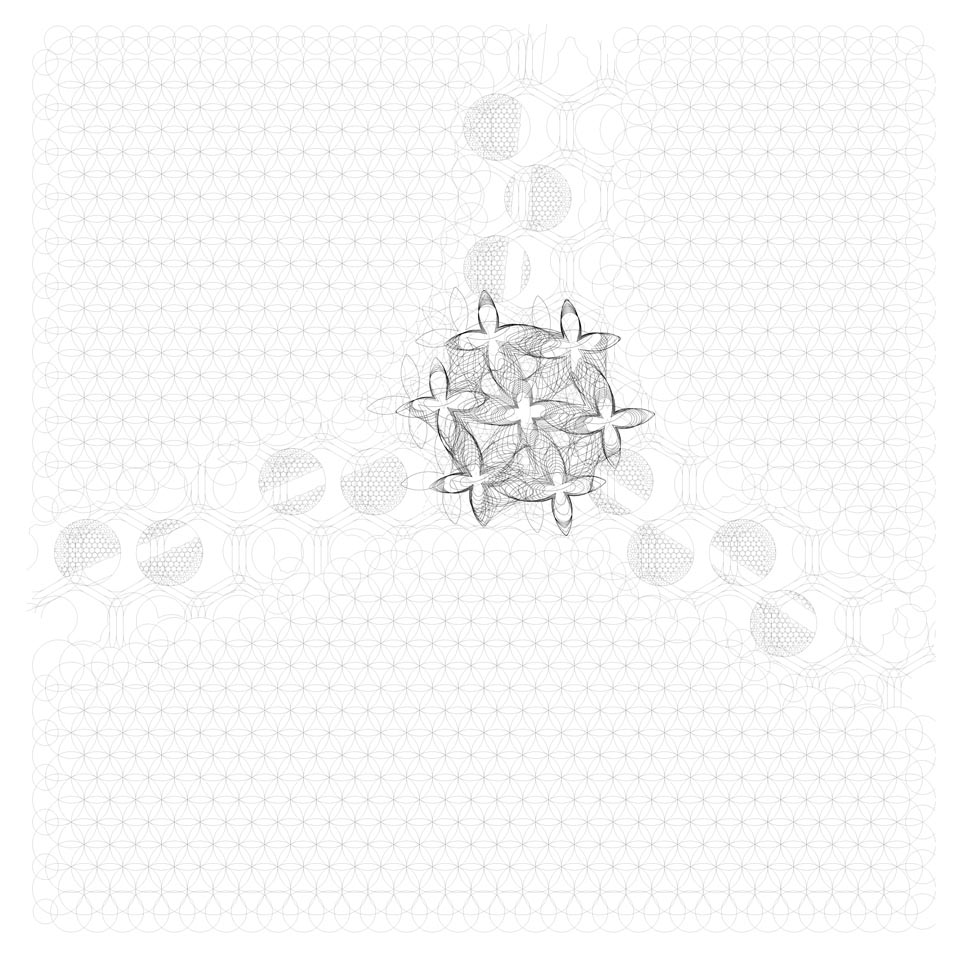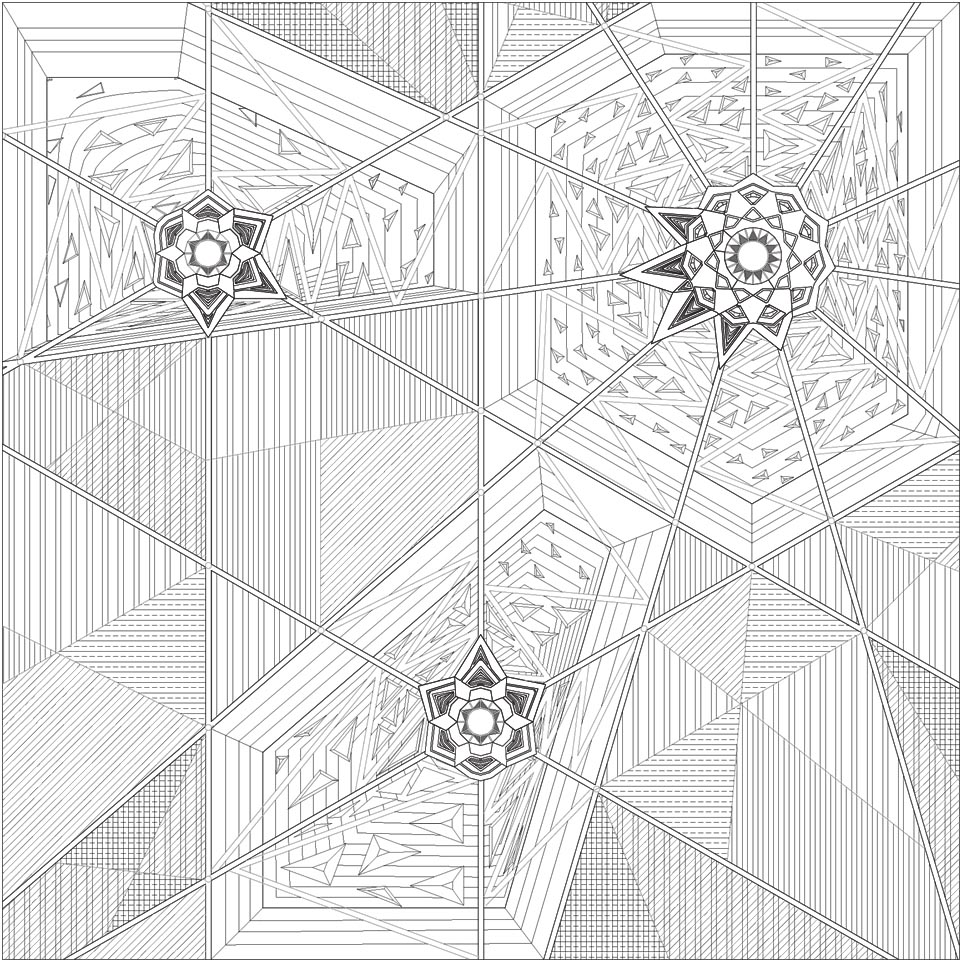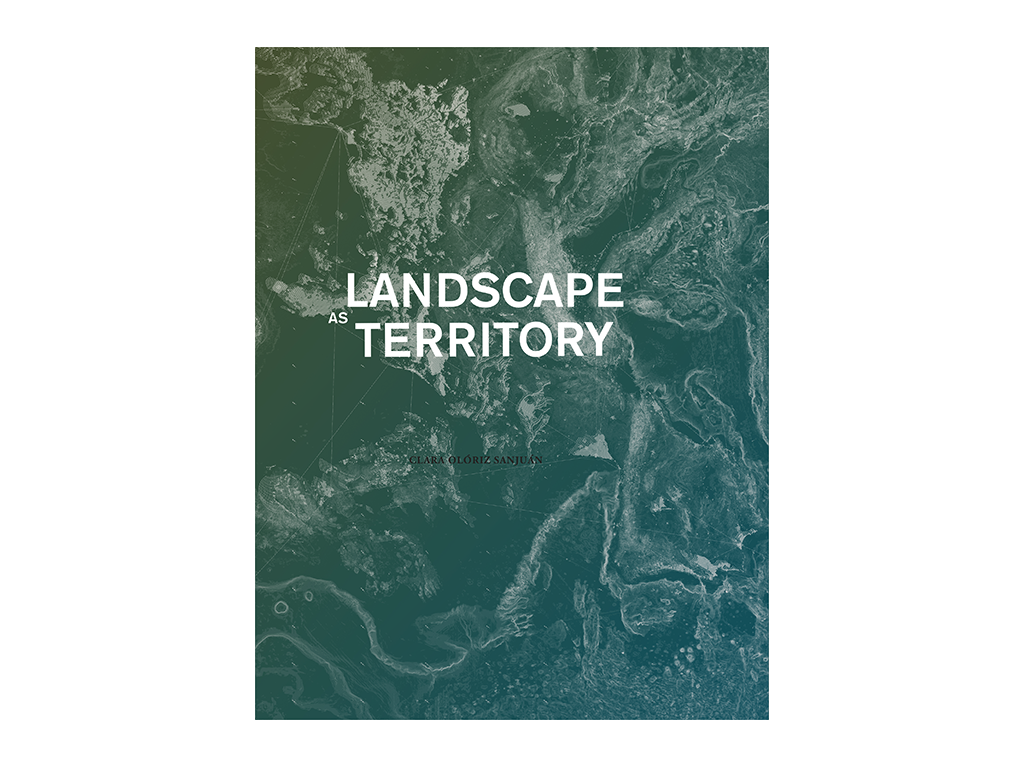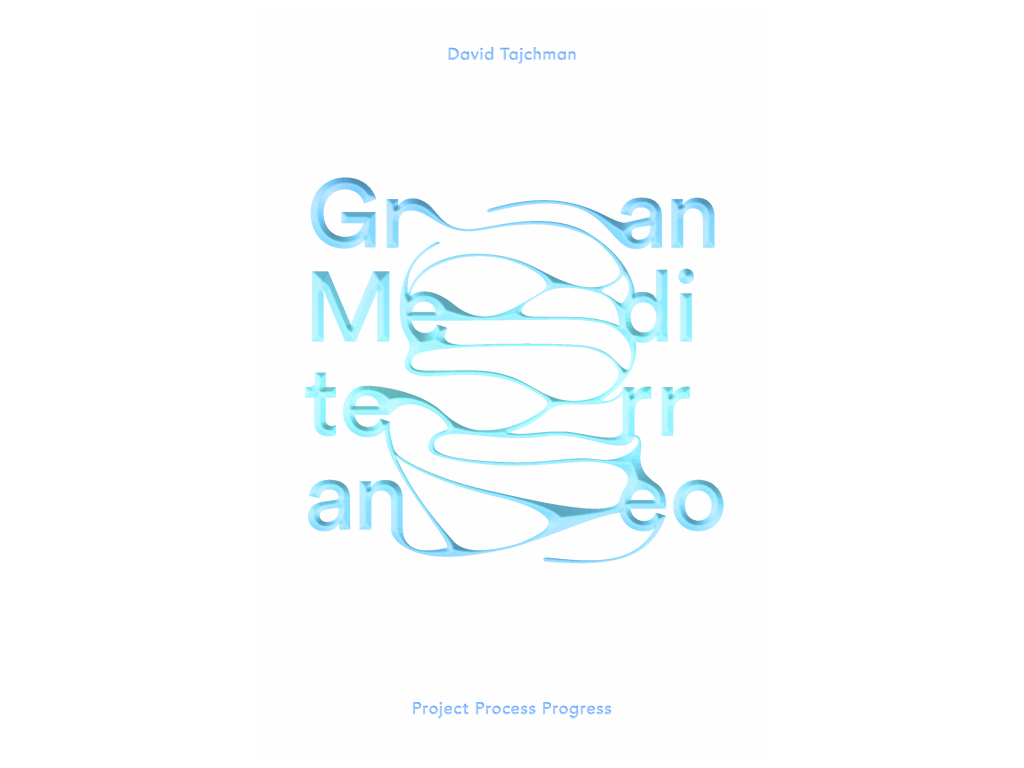Suprarural claims a new domain for the practice of architecture. By turning the discipline’s dysfunctions vis-à-vis the urban and its systematic oversights regarding the countryside into a new set of opportunities, Suprarural issues an urgent call for a theory that can overcome both and extend the spectrum of capabilities of architecture by engulfing the ordering systems of the territory. The project is carried out through a program of investigation that takes the know-how embedded in the rural—its organizational protocols, its synchronicity with the natural, and its often disregarded technification—as the raw material for a new form of architectural expertise.
The opportunity provided by the investigation is not to be confused with simple convenience at a practical level. Neither is it meant as a new rhetoric of punch lines and improbable statements, merely ironic or amusing in nature. Instead it involves an earnest plea, mobilized by virtually playing with the territory itself. The seemingly ordinary scenario of this game—that is, the fundamental operative failure of the rural domain in the face of the ubiquitous forces of urbanization, and what appears in principle as a thematic outmodedness—is reversed here into a panorama of unprecedented potential, and embedded with straightforward techniques, vibrant organizations, and new figures.
Suprarural’s call for the rural, that marginal, enigmatic, and apparently minor territory of discussion, is directed to challenge and problematize the condition of the Suburban by turning its ubiquitous model inside out and threatening it with the dark side of the commodification of the territory. The Suprarural is the underside of the myth of endless urban expansion. It involves the intensification of the rural into architectural singularities, rather than its annihilation by the urban, and calls for extreme exposure rather than refuge, engagement rather than retirement, radical technification rather than primitive form, and for the sophisticated wilderness of post-urban uncertainty rather than the domesticated mildness of pre-urban nostalgia.
In past decades the discipline has gone through a triple displacement.
To begin with, it has moved from satellite representation to the simulation of systems that manage the complex fluidity of territories beyond political, social, and cultural boundaries. The ethics and tone of this development have also gradually shifted from different versions of landscape urbanism to various ways of appropriating ecological models for a wiser understanding of the urban. It has thereby established an array of roles for the ecological condition as part of a wider geopolitical project, directed at integrating contemporary processes of urbanization in a single inevitable trend by using the metaphysics of survival and the myth of sustainability as its perfect vehicle.
Secondly, the discipline has displaced its focus from the object to the ground by engaging geographic positioning systems, renewing its forms of mapping, and refining its procedures through the popularization of field and systems theory. This shift has recently flipped back into the vertical, with the ground itself becoming the new condition of the architectural object: monumental, geomorphological, post-utopian, and figural. As a consequence, the organizational potential of the dynamic complexity of the territory—multi-scalarity, multi-temporality, trans-specificity, and pre-urbanity—have now turned into cartoon-like figurations that now promise to provide architecture with a solution to the conundrum of its orientation towards service through a renovated palette of persuasion.
Thirdly, a cultural shift has taken place, from the general idea of practice as a meta-domain that integrates different disciplines to a polarization between the inter-disciplinary ideology of climatic change and the regressive ethics of the old notion of autonomy, clear expressions of the rapid consumption of ideas and cultural constructs at work in contemporary culture. It seems that the expansive role of the architect as a mediator operating within the systems—an agent installed half-outside of them and an artist working through them—has declined into a model in which the modern notion of the architect as a former ideologue, now expatriated to a post-postmodern, retro-ideological, pseudo-political scenario, has taken over design research, turning it into an enemy to be obliterated from the firmament of serious architectural thought.
In this context, Suprarural aligns itself with systemic thinking and its persuasive promise of empowering the architectural project with robust structures. But this alignment is performed amorally, and with an important dose of lightness. Its protocolar machine is not conceived as an ideal means to something else, like a manual of instruments waiting to be used for the right purposes, but as a constitutional state of the in-between, which, like it or not, does not close the perfect circle of the traditional typological manual. Thus the work is not a body of research that operates within the scientific tradition without friction. Even though characterized by identifying territorial conditions and configuring the distinguishable organizational models through which they can be competently directed, on a more basic level it endeavors to open up new spaces of imagination.
Suprarural is, in this context, regarded as a medium of design operating through a standard that develops focus through and by means of production, allowing external inputs to constantly force the re-description of its models. Its methodology is thus directed at progressively constructing relevance in iterative loops, not through sense but through reverberation. The Suprarural is a platform that constitutes meanings of a kind, singularities through consistency, order through resonance. It seeks to deploy power by formulating new questions, without necessarily answering them. Similarly, the rural protocol is not to be seen as an instrument for arriving at a Suprarural status, nor is it assumed to be good per se. Instead the rural is the device through which the Suprarural, that blurry vision, can perhaps be instilled into our worldview and enticed into the real.
Diagram as recursive model
Suprarural consists of a set of informational regimes that index the existing formal organization of the rural. This set involves diagrams that collect intelligence from rural systems and integrate their rules into abstract models. The construction works as a design platform through the actualization of territorial latencies. Constituted by protocols made up of different ranges and scopes of performance, the Suprarural allows them to be redefined by various forms of feedback with each other, displaying them and making them perform against one another. In that sense, the Atlas of Rural Protocols is not so much a set of components whose instrumentality is external to their form, as a fluid medium that establishes continuities between potentials latent in the material world. Traditional representational logics, in the context of which drawings refer to external forms of meaning that engage existing cultural narratives, achieve here a status that takes the non-representational nature of the diagram to the level of an abstract register in a territorial model. The systemic condition of this diagrammatic form conducts the rural material to a plane where action and representation are one, operating together by making their relational structures explicit and constantly refining their protocols of description. The Suprarural diagram is a recursive model amongst rural protocols.
Normally, organizational protocols operate through the definition of constraints and the recognition of performances with various levels of redundancy. There is no requirement, in principle, to model them in the direction of the construction of ideals, nor is there a will to design idealizations, but rather an immanent desire to mobilize reverberations through design by intensifying them as instances in larger processes of differentiation, magnifying attributes of the organizations to a point where they are no longer efficient in their original terms, and launching a wider range and higher level of performance, now charged with a broader agenda. This lack of idealization of the rural does not mean that there is a similar loss in the legibility of its character. Only that it is forced, here, to become operational and forward-looking, referring more to a form of imagination grounded in simulation and a sense of opportunity than to a figural resemblance to past references. The opportunity for these actions is guided by the proximity of usage, and evolves through perpetual refinement, lending as much attention to the progressively emerging target as to the gaps lying or arising in between. The gaps between protocols have, so to speak, a life of their own, and themselves become the engine of potential constructs, thus blurring the boundaries between sources and meanings, and revealing a deeper passion for the leaps embedded in continuities than a loyalty to conserving them as they are. The ideal within the Suprarural operates as a sort of shadow or, better yet, as a fog of indistinguishable grays, enigmatic in-between states, slippery nuances, and smooth edges. Ideas flicker within this fog, sparkle and become sharper at times, and proliferate in an endless game of readjusting targets and alliances.
Technification as differentiation process
Apparently bare and devoid of architecture, the American Midwest and the Argentine Pampas are highly technified territories that constitute, virtually or actually, consistent forms of extraordinarily large architecture. While in the industrial era the local was merely a by-product of a larger production system at work invisibly across regions, its post-industrial technification operates as the condition of possibility of a global dynamics. The mechanical process was, in modern times, transversally isolated, functionally specialized, technically optimized, and driven by single-minded forms of efficiency, for the most part alien to the multivalent potential of material systems. Currently, it is the material systems themselves that are being machinized and made time-efficient, multi-purpose, and distributed. And therefore the larger systems in which they take part have become highly volatile, configuring a ubiquitous architectural project that resets, each time and by means of local protocols, the normative conventions by which its generic structures operate. This peculiar coexistence of bottom-up self-organizing processes and top-down territorial design strategies implies both a threat to and a challenge for architecture: either it is swiftly left out of any influence at a geopolitical level, or it is compelled to function as the sine qua non mode of control of territorial form. The shared know-how and ownership system that is embedded in local processes commands the globalized dynamics of technification without even noticing it. And, in this context, the discipline is confronted by the possibility of constructing new and expansive forms of knowledge by simply articulating local organizations and nurturing their outcomes from within, and yet exceeding the rationality of their production frameworks. The particular and the generic are enabled to perform not merely as polarities in a process of mutual feedback between local events and global conditions, out of reach for the architect and exclusive of other forms of expertise—geopolitical, geological, ecological—but to become the matter of an architectural project themselves. Architecture now has the opportunity to unleash singularities that can become generic systems of a second order: the territory as the ultimate form of architecture.
Furthermore, rural organizational techniques working at a local level exhibit the capacity to not only articulate global processes at a territorial level but, more importantly, to change them from within and transform vast territories along the lines of increasingly convoluted and yet extremely simple patterns. Architecture can take on board this expansive capability, not just by contributing to the organization of the local performance of these patterns but by intensifying them in a symphony of redundancy at various scales, allowing generic territorial structures to be differentiated on the basis of manifold local, regional, and global inputs, rather than operating within the range of encapsulated forms of material efficiency alone. If we read the globe as a single yet multiple informational model, productive in nature, neither urban nor natural as such, the redundant structure that this model embodies allows any form of know-how to be integrated and creatively synchronized, rather than disappearing as mere background noise in the sea of global-local efficiencies. Rural patterns can thus be said to operate as the basic organizational matter in a broader scheme of redundancy management, absorbing, with material directionality, information coming from a wide range of inputs, from the hyper-local, accidental and contingent situations of the farmer to the homogenizing tendencies that are linked to large-scale corporation logics. As a consequence, these patterns should not be understood as averages or as mere negotiations of existing conditions but as incomplete collective constructions that deal with various modalities and intensities. Catalysts of a world of simultaneous processes of differentiation, rural protocols are the ultimate triggers for the constitution of global orders, megalomaniac and yet inherently architectural, self-alienating and self-transforming at base. Architecture is the most appropriate means for the world to problematize its comfort zones of territorial efficiency through an artistic model. Inputs of extremely different kinds and degrees can be integrated within such fluent structures, where systems provide feedback for one another in loops of proliferating or balancing patterns.
Assemblage as formal technique
How do we work in a context where systems have an open logic and are robust enough to adapt to contingency yet still operate within a narrow range of performance and a very limited world view? How do we expand the narrow-minded, inward-looking scope of performance of rural systems into broadminded, generalist ones, and do this from within, rather than from without? In other words, how do we move from the local-global dichotomy, based on the opposition of rural versus urban, to the ubiquitous-singular model of the Suprarural Cosmopolis?
The convention of constructing hybrid or counter-intuitive figurations by articulating fragments through montage has been the customary formal technique to decontextualize typologies in patchwork-like or field-like landscape proposals since the 1990s. However linguistically curious, formally poignant, or conceptually innovative, these techniques have proved to be limited to the rarifying capabilities of formal disruptions or collisions of opposites. They generally operate within the boundaries of the architectural object, no matter how expanded in scale. And by solely referring to the traditional representational conventions of architecture, frequently based on dichotomies like natural-artificial, inside-outside, rural-urban, full-void, ground-object, soft-hard, open-closed, among others, these techniques lack the organizational effectiveness that they promise and the formal fluency that give them significance. They are there to help evoke a world project by imitating ecologies through static representations of complexity, often metaphorically. But they fail to respond to the challenge of constructing the material means of a geopolitical model that might integrate dynamic attributes in forward-looking simulations. By working with static assemblages of objects, these lineages are unable to root themselves in the more abstract register of the protocolar and therefore to technically lead a rigorous design process with the capacity for establishing supple and adjustable relationships. By being focused on immediate figurations and on the mediatic impact of the rhetoric of form rather than on dynamic organizational capabilities and on the potential of form to have an actual influence over the processes, they fail to recognize the very basic transformational capabilities of architecture that lay not only in persuasion but also in maneuvering performance. The notion of dynamic assemblage, based on the organizational latency of protocols, relational and relative in nature, is conducive, instead, to the integration of subsystems and to the creation of expansive trans-scalar figures, legible within the global continuum at many scales. The local becomes, in this context, not just a figure operating at a discrete scale, but an index of larger systems, whose organization it contributes to at a deep structural level.
This second order of assemblage is constructed by means of two levels of operation: one that recognizes systems, breaks them down into the smallest protocolar relationships, and constructs a manual of variations of those broken-down attributes, and another one that puts these attributes and relationships together and builds up progressively robust assemblages. However, the logic is not linear, as if moving from unit to set, but rather circular, as the resulting assemblages feed back the systems break down, altering the original protocols and endowing them with renewed potential. In a way this circular process works like an endless dice game that constructs ever-higher forms of chance. Far from being consecutive steps in a traditional deterministic process, these iterative throws of the dice operate as forcefully deterministic actions, where everything is necessary and actually wished for retroactively. The process is not just a way to justify the outcome, but rather the opposite: it is the outcome itself that constructs legitimacy in reverse. Or better still, both process and outcome keep the feedback loop they partake of in motion, as a motor of determinacy. Global design thus becomes relevant and persuasive not through the artificial magnification of localities through fields or patchworks that extrapolate and generalize effects, but rather as the intentionality in-built in a feedback process that transforms itself en route, setting constantly new agendas and altering the directionality of the forthcoming ones. Such a process works as a sort of vibrating machine, overcoming the segregated condition of protocols by escalating and looping back their abstract regimes.
Protocols as abstract regimes
For this dynamic assembly loop to be possible, there must be a set of inner regulations that can both build the coherence of the particular subsystems and trigger their self-transformation. Rural protocols are not just formal rules that determine relations in an absolute, permanent manner in the direction of the making of closed, descriptive procedures, but are instead relational logics of performance that connect with others and are capable of setting a generative engine in motion. This is one of the main purposes of the iterative use of protocols: to develop a successive mediation directed towards an increasing and progressively expansive form of abstraction. Once the embedded efficiency of systems is released from its restrictiveness to other systems, often assumed to be necessary, protocols become a potential part of a larger synthetic machine, in which the evaluation of performance is set free from its single-mindedness, unfolding and multiplying effects in their context. Designers become complex-system-designers and construct conditions for architectural inventiveness through the abstraction of protocols that, in turn, start operating in directions which diverge from the original instructions. The inner material logics of protocols are not simply removed in a process of abstraction but rather the opposite: they become intensified and freed of the consecutiveness of the linear processes they take part in. Material logics transform differentiation processes in convoluted patterns that contain a manifold of potential actualizations that circulate in constant feedback, oscillating between an inherent abstraction and a progressive charging of meaning and sense. This oscillatory loop promotes the engagement of the unknown as if it were known in advance, encouraging invention and operating as a rigorous but open-ended game of managing potentials.
There is a form of vitalism embedded in such a circular design process, but it is a circular form that embraces chance, intense counter-intuitiveness, and radical arbitrariness as a condition of existence, performing through the mutual adjustment of the outcomes and the protocols that set up the game structure. There is no such thing as an idealized form of efficiency, nor is there a vector of progress which can be claimed in advance or demonstrated as being necessary, not even in a nonlinear version. Instead it is the ongoing convolution of expertise in the systems of rules and the precision of the outcomes what continuously nurtures the game, taking its intelligence and playfulness to a higher plane. Far from operating as rules of the sedimentation of know-how, and farther still from defining a coherent model of increasingly refined efficiency, protocols assume the role of being the dischargers and the receivers of a design machine that works by ceaselessly shuttling back and forth between the constituency of rules and the organization of by-products. The Suprarural is a source of protocolar intelligence and rural protocols the transitory sediments of an unending game. A protocol-based system of rules is therefore not just a system of nonlinear control but a system of interferences that, depending on the moment, may behave as a driving force, a source of restriction, a resource of conceptual construction, a vehicle of disciplinary problematization, a device of performance evaluation, or a reserve of cultural value. Here, techniques, figures, norms, references, and forms meet in a medium that changes register when necessary. The Atlas embodies just this multivalent medium.
Atlas as political engine
The Atlas is traditionally an instrument of territorial design. The very rationale of its format consists in being able to hold and navigate across the most diverse types of information in a systematic way, the ambition being to create the conditions of a comprehensive totality. However, the Atlas not only works as an all-inclusive mechanism that serves as a passive instrument for fixing and arranging different points of view, but also as a biased platform that redefines perspectives, facilitates novel worldviews, and activates the configuration of new questions and the transfiguration of what is taken to be a given. The Atlas is a plural, multidirectional diagram, a multiplicity of blueprints that forces the user to formulate questions. It is a transformative tool, not just a compilation of inert conditions systematically displayed and made available for the increasing knowledge of an impersonal reader located at an abstract infinite point, fully detached from the real and rendered ever-conscious. Through its systematic structure, it traces the preliminary conditions for new organizations to take place through an active interaction with the reader, an interaction conditioned in turn by its content and techniques. Its drawings create a nature of their own, its techniques construct an operative language, and its chapters structure new frames of mind. The Atlas is an aggregation of voices that expand a spectrum of interest, a multiplicity of images and autonomous documents that proliferate in an open-ended series of collections, a set of captions that multiply the links between artifact and potential. Its objecthood coalesces the disparity and incompatibility of things in a multitude of provisionally coherent systems of relationships. This simultaneous ability of endlessly incorporating, possessing, and sustaining the world in a limited space is accompanied by an equally fluent capacity for spinning this material around itself to create new worlds. Its diagrammatic nature is there to catalyze otherwise disconnected and senseless information, and purely out of reverberation, it works as a tabula for the development of consistent design strategies.
Far from wishing, then, to provide a fixed portrait of a territory, made transparent through a precise system of coordinates and a coherent set of instructions to understand and use it judiciously, this Atlas defines the conditions for a series of active relationships that oblige readers to take alternative positions within the territories under question. In other words, it is not a means to safely locate the reader in an otherwise unknown territory—that is, an apparatus of knowledge that preserves the subject’s prudent detachment from the real—but a weapon to empower action on the real and engage with the potency of the unknown. The Atlas is a political engine, and requires of the reader an equally earnest will to become an agent of information management. It is a means of unscrupulous resourcefulness, not just a means of disengagement and comprehensiveness. Manifold actualizations that are imprudent, blunt, forceful, and unnatural, are embedded in its pages. And yet, these actualizations are neither infinite nor gratuitous. They demand projective reading. An Atlas is not a means of indifference but a vehicle for differentiation. Its pages are not flat screens that make knowledge available, but unforgiving sheets that only open themselves to the playful reader who can work transversally in relation to their sequences, submitting to their rules of thumb in order to play a game with them.
The rural as pre-architectural condition
The organization of the rural is regarded as a pre-architectural condition whose pattern is embedded as a dynamic intelligence and can foster different urbanization processes. The rural is not presented nostalgically as an inert or obsolete organizational condition waiting to be transformed by urbanization, but rather as a particular structure within which latent architectural systems are ready and willing to be intensified and equipped with prospective properties. The rural works as a set of subsystems operating simultaneously, partly in consonance, partly in parallel. Its substructure is grounded on natural systems dynamics: seasonal to daily weather variations, various conditions of topography and water flows, animal behaviors, a limited array of ecologies supported by different technological regimes, artificial drainage systems, infrastructural systems, land division systems, animal management systems, sow and harvest systems, and storage systems, which are activated and determined by a range of economic forces, mostly concentrated around agricultural production and cattle, and permeated by habits, rituals, routines, and various cultural traditions, historically characteristic of the prairie and the flatlands. The formalization of those systems and their performance gives a clear identity to the landscape of the Midwest and the Pampas, and builds up conditions of possibility for urban organizations to happen. In other words, the Rural Atlas is not simply the result of stabilizing rural culture by capturing it in poignant images, but the raw organization of a prospective capability to create unprecedented urban-territorial cultures. If the rural is a matrix of preliminary inputs in a potentially evolving system rather than a given state of things, and if the transformative propensities that develop within these inputs is forced to configure questions that can surpass their status quo rather than be assumed as self-explanatory frameworks, the logics of rural production can be said to already contain logics of urbanization, as if on hold.
The substructure of the rural is differentiated through a series of evaluations that drive the feedback of its current situation with new principles, thus intensifying or modulating its embedded architectural attributes. The outcome of this process is an in-between condition, neither rural nor urban, or both, performing simultaneously at different registers that evolve in time and are fueled by architecture. In other words, the Suprarural does not bring any stabilization or consolidation into the rural, nor does it bring an imposed kind of change into it, but recognizes and upgrades its in-between condition and takes it to another level of complexity, with a higher cultural standing. Some of these actualizations work as material sets in evolution, in the sense that they nurture material organizations that already have their constraints and regulations inscribed within regimes of equilibrium or diversification. They can be regarded as entire cultural mindsets in their own right, in the sense that they operate at an abstract linguistic level, in reframing systemic correlations by re-conceptualizing their territory of pertinence. The dual material-mental condition of the rural is integrated within the two simultaneously multifarious and dialectic layers of the Suprarural, where the design of material organizations requires a new conceptual apparatus that can channel its potential, and vice versa, a whole series of material-based routines that can implement such forms of knowledge. The complex loop established between the two layers, each of them inherently multiple and convoluting, is seldom smooth and linear. Instead it is able to generate manifold tensions and disruptions, which oblige the notion of the Suprarural to be permanently provisional and subject to definition.
Supra as meta-authorship
Supra, as in Suprarural, is the default condition of meta-authorship. The Suprarural constructs an abstract machine for overcoming the dichotomy between subject and system by means of the internal differentiation of regulatory norms into creative guidelines; that is, of norms that are capable of challenging their own range and mode of variation, paradoxically unfolding their expansive power by accumulating and integrating specifications and various forms of know-how. The Suprarural configures a pre-architectonic ground, from which many, albeit not infinite, architectures are possible. It abstracts, organizes, coordinates, and integrates the latent architectonic potential contained in the rural and, through iterative processes of intensification, actualizes their urban power. If the systemic non-author, fully embedded within systems, was capable of transcending systemic logics by managing their potentials from within, the Suprarural meta-author designs systems of systems, operating from both within and without, making sure not to patronize the outcome as a superior, seemingly natural state that follows on from surpassing the threshold of nonlinearity. Instead the meta-author assumes this extra-threshold state as something entirely artificial, and regards its construct as nothing other than his artistic duty, going beyond the intra-systemic notion of the in-between and overcoming the natural-urban opposition implicit in its ethics. This movement that actualizes the intra-systemic fable of self-organization into the supra-systemic artifice of localizing architecture both inside and outside of systems makes use of the circular loop of feedbacks between rural normative and urban restrictions as the basic definitions of a ubiquitous urban/territorial model. The practice of architecture overcomes the inter-disciplinary myth and ceases to be a mode of transferring knowledge between fields in order to become a mode of unfolding consistencies across fields, precisely through architectural expertise.
Meta-authorship overtakes both the representational traditions of authorship based on ideas, concepts, narratives, or commentaries, and those that either refuse them by recourse to a politics of anti-authorial critique or bypass them by means of an ethics of systemic integration. It involves the blunt differentiation of existing orders—and orders of orders—without falsifying them. The rural, a virtual datum within which this differentiation is developed, is not a tabula rasa and it does not allow creative narratives to be projected or instilled without grounding themselves in its normativity. Rather than discouraging creativity, this void-like inertia encourages authors to engage with extremely slow and at times dumb and pointless processes, with particular design operations that, in the midst of the more intense homogeneity and indifference, differentiate the nuances and hidden striations of this apparent nothingness towards a new status of organization. The subtle legibility of the systems of the rural does not merely call for a subjective projection on the part of the author onto what is regarded as sheer emptiness, but is the most fertile medium for the construction of meta-authorial practices that nurture systems, inherently banal and often insipid, and cause them to collide with each other. The Suprarural is, so to speak, the odd state of the art of the rural, both constraining it anew and upgrading its operations into unforeseen design actions. The figure of the author is not repressed here by superficially heroic but deeply authoritarian single-statement propositions, which arbitrarily and suddenly change the conditions of the land for a more efficient urban usage, nor does it celebrate the multi-statement or the anti-statement-type proposition of the post-authorial. Instead the Suprarural opens up a whole new set of authorial forms. It calls for a collective form of authorship, not in the sense of an interdisciplinary ethics that dissolves design expertise via politically correct committees, technocratic think-tanks, and paternalistic systems of participation, but by putting authorship under a high level of stress, and by consciously misusing the deceptively indifferent organizational forms of the rural.
Midwest-Pampas as geopolitical project
The Midwest-Pampas is a dual geopolitical arena that articulates cultural, economic, historic, and technological determinations in a plane of consistency running along a north-south axis, parallel to that described by the two American metropolises, New York and Buenos Aires, major trading gates between Europe and America, through which the mainstream flows of immigration of peoples, goods, and civilizing drives has taken place during the 20th century. Ingeniously synthetized by the bifocal map of Le Corbusier in Precisions (1930), this axis of the continent’s unavoidable destiny grew weaker as the metropolitan model of huge capital cities and hinterlands was replaced by the distributed model of regional networks, installing a new form of geopolitical life. The north-south Midwest-Pampas axis runs today in a precise longitudinal parallel to its metropolitan predecessor and articulates not a model oriented by the inward-outward relationships between the continent and the ocean but one where interior and exterior coincide and pulsate from the two largest agricultural plains. By means of this displaced centrality, the Suburban model, dominant expression of the decaying megalopolitan stage of those two major urban centers, encounters now its antithetical reversal, the Suprarural, expression of an upcoming urban territory, alternative to the regional network model in which it allegedly takes part. With the fundamental capacity to carry the production of a concealed quantity of reserves at the verge of an age of acute lack of resources, this post-sustainability model promises to articulate the potentials of a production map that transforms the outdated model of the rural into an over-technified form, overwhelming the urban as we know it.
It is in this context that the massive monotony and ruthless insipidness of the Midwest and the Pampas build up a new form of cultural prosperity based on the economics of the countryside. If observed with low-resolution lenses, its principal attributes have the aspect of a brutal, crudely homogenous and straightforward territorial archetype, almost dull in its formal frankness and aesthetic earnestness. The prairie is a childlike territory, immature in its form, and candid in its organization. And yet its flatness, figural manifestation of an uncompromising mindset, unveils a landscape of nuanced differences. As its vastness cannot conceal its richness, lying a meter down, far from cancelling differences, it makes them all the more evident and auspicious. The Midwest and the Pampas are fine-resolution fields capable of responding to almost any action, no matter how tiny, casual, or irrelevant. The prairie is a field where any action gets effortlessly escalated to extremes, and immediately projected onto a firmament of hope, imagination, myth, and vision. Laid-back investment, prolific production, and fast development are all proof of the simple theorem of this magnifying plane. Notwithstanding its calm, tranquil appearance, its responsiveness to stimuli is unexpectedly excessive, engendering uniqueness and otherness through sheer quantity and density. The Suprarural becoming of the continent calls for a refocusing on the ground, now in a paradoxical role: to be both the support of a highly rationalized mechanism of capitalist production and the nurturing nature of the machinic sublime.
Three attributes are the expression of this rare splendor. The first is the non-horizontal property of flatness, and unfolds as the natural manifestation of how an opulent field reacts to simple actions of colonization, namely through sowing and harvesting, triggering convoluted design loops and spinning formal patterns that literally cause the ground to revolve. The second attribute is the historical evidence of the fact that the vertical elevation of anything working anti-gravitationally against the dominance of flatness becomes a figure of praise and glory, no matter how banal. Sources of landscape legibility, rhythm, depth, and orientation, such emergences in elevation—machines, trucks and vehicles, abandoned tools and objects, giant trees, medium-size forests, raw constructions and industrial naves, infrastructural ruins, silos and windmills, animals, and even human figures—distinguish themselves as the sudden heroes of the expansiveness. Finally, a spherical flatness, fashioned by the extreme proportions of the plane, resulting from merging the 360-degree horizon with impossible swelling curvatures. This traveling horizon is invisible in other types of fields, except perhaps for the oceans. Curved horizons, rasterized soils that curl-in-flatness, spherical skies that surround the space with explicit, often poetic, meteorological and astronomic processes bring the earthy constitution of the rural to an oceanic perspective. The ruggedness of the populated horizon and the mirage of the atmosphere give the flatland a dense character. Horizontal, passive, homogenous, endless, universal from one perspective, vertical, revolving, unique, counter-intuitive, singular from another, and curved, surrounding, encompassing, exposing, from a third point of view, the flatland portrays an active three-dimensional field that builds up design actions as if naturally, from the tiniest stimuli, becoming a territory of clever navigation and expansive differentiation. Le Corbusier’s map, that megalomaniac enterprise across the unexplored edges between oceans and continents, operating within the two-dimensional framework of the modern universalizing ground, is now flipped by its parallel counterpart, the intensive consistency of the Suprarural, that ubiquitous biological machine of impossible escalation of minor actions through the revolution, verticalization, and curving of the flat by means of rural protocols.
The art of territorial activation
Grounded on the nuanced uniformity of the flatlands and nurtured by its inexhaustible plane of consistency, Suprarural defines the territory of a ubiquitous practice. It adopts the formal norms and informal routines of the rural, reframes them in an Atlas, and sets up the rules of a game of feedback loops that integrate capabilities in a collective development that largely exceeds the communitarian. Without softening the powers embedded in the real, but instead furthering their subtleties, it boosts the sensibility of the rural with an open-ended spectrum of architectural imagination. The techniques of this Atlas are organized according to a series of rural systems: transport and infrastructure, land subdivision, agricultural production, water management, irrigation and fumigation, human inhabitation, cattle management, socialization, storage. These systems are described as protocols, that is, as rules of engagement with other systems. These rules are defined as simple variations of a series of variables, which, responsive to the variation of other variables, connect systems with one another. Variables synthesize the behavioral regime of systems, often obscured under the guise of habits, routines, and rituals, and only in particularly industrialized cases considered as intelligent, determinable, and predictable. However, these variables, mechanized or not, constitute one of the clearest procedural bodies in the world, consisting not only of mechanisms and instruments of territorial determination, but also of devices, tricks, and trickeries to adapt to the manifold contingencies and accidents that such prolific territory can bring about. Sensible, sensitive, practical, down-to-earth, sequential, astute, prudent, tactile, simple, economical, these rules construct the machine of sensibility of the flat plain. They regulate processes of high efficiency and adaptability with low cost and energy. They are transmitted through the generations without ambiguity, or better yet, with exactly the necessary ambiguity to enable change under unusual circumstances. If anything, rural protocols show that sustainable architecture lies in the methods more than in the artifacts or the materials, and that there is no higher-end technology than an advanced system of abstract intelligence, simple in its instructions and sensible in its performances.
Suprarural has a main structure based on the integration of these rules in a loop-based model that moves back and forth between systemic protocols and articulated projects. If rural systems are described as a detailed taxonomy of existing principles of organization, Suprarural projects are made up of the ways in which these principles distance themselves from the systematic documentation of the catalog through its intensive differentiation. Suprarural is no more related to the specificities of the original framework of efficiency of rural protocols than it is made present through the nurturing and strengthening of their embedded architectural potentials. Through the intensified actualization of rural systems, isolated, intertwined, and mutually activated, the Suprarural works as a dynamic assemblage that reduces the responsibility of the comprehensiveness of models in order to articulate and magnify particular iterations of the architectural structures latent within systems. Such intensified actualization is a diagram in itself, fed by protocols that get continually indexed and integrated in the framework. New frames of evaluation are constructed, investing the rawness of the rural with a progressive directionality. The loop slowly constitutes a complex set, and keeps incorporating determinations as it evolves as a vision. The Suprarural project thus remains an open question and retains its in-between nature as an essential part of the further development of its procedures. Narratives are left open, ideals are made relative, universals are subsumed to their own vacuum, and permanence remains unspoken. The generality of Suprarural models consists of the becoming singular of recurrent games between regulations and emergences. Clearly not a defined product, Suprarural is one design phase among many. Its visions are both bred in and removed from the statics of the rural, and impelled towards the configuration of artistic territorial actions. Suprarural is, in that sense, the art of territorial activation.
Figure 01 | Suprarural: Architectural Atlas of the American Midwest and the Argentine Pampas
Ciro Najle and Lluís Ortega
Collaborator: Anna Font
Region: Argentine Pampas
Project: Ville Irrigation, The Modern City as an Agricultural System
Student: Paula Maidana
Figure 02
Region: Argentine Pampas
Project: Grid Games, or the Hedonist Territory
Student: Martina Rossi
Figure 03
Region: Argentine Pampas
Project: Cattle Mall, Vertical Handling Machines
Student: Juan Cruz Río
Figure 04
Region: Argentine Pampas
Project: Silo-roads, Agro-productive Urbanism
Student: Andrew Pringle
Figure 05
Region: American Midwest
Project: Vertical Land Ordinance
Student: Travis Kalina
Figure 06
Region: American Midwest
Project: Sprinkler Towers
Student: John Sohn
Figure 07
Region: American Midwest
Project: Starbovis
Student: Taylor Holloway
